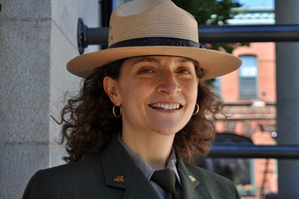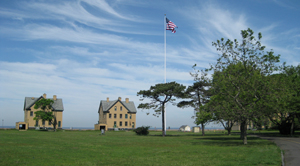National Park Service Aims to Attract a Diverse Crowd With Help of a Rutgers Alumna
Jennifer Nersesian oversees Gateway National Recreation Area spanning Sandy Hook, Staten Island and Jamaica Bay

‘Without people coming here for whom this is meaningful and relevant we don’t have much of a future. We need to have a constituency who values the parks, and we will never have that if what we are offering is not valuable to them.’– Jennifer Nersesian
Jennifer Nersesian runs a national park with pristine beaches, historic military sites and superior birding and fishing in a densely populated area, which makes the greatest challenge she faces as superintendent of the Gateway National Recreation Area surprising: visibility.
As the National Park Service prepares to celebrate its 100th anniversary next year, Nersesian – a 2002 graduate of the Rutgers Edward J. Bloustein School of Planning and Public Policy – is preparing to tackle a dilemma that plagues the institution nationwide. She is working to attract a new generation of parkgoer in the face of changing national demographics.
“The traditional park visitor is someone who is 65 or older, white, highly educated and their family has come to the national parks for generations,’’ Nersesian said. “That is not who America is today and that is not the way our demographics are moving. We want to connect with who people are, to bring a whole new generation to enjoy the parks and be our future stewards.’’
The Gateway National Recreation Area spans 26,000 acres from Sandy Hook in New Jersey to sites along the northeastern shore of Staten Island and Jamaica Bay in Queens. It includes Fort Wadsworth, one of the oldest military installations in the country, which rests in the shadows of the scenic Verrazano-Narrows Bridge; Floyd Bennett Field, the first municipal airport in New York City, where a group of World War II veterans works to restore a fleet of historic aircraft; and is home to the only wildlife refuge in the national park system.
“We are in easy reach of 10 million people,’’ Nersesian said. “We are perfectly situated as an introductory experience to lead to a long-time love of national parks. But how do we fulfill that mission to welcome folks from New York and New Jersey to our national parks?’’
Nersesian’s passion for preservation and the environment grew after she completed her undergraduate degree in philosophy at Rutgers. She continued to live in the New Brunswick area and worked in video editing, animation and software development. But she started to realize what she cared about most were the challenges created by rapid development in Central Jersey and the race to conserve open space and protect national resources.
Nearly a decade after completing her bachelor’s degree, Nersesian enrolled in the Bloustein School at Rutgers to study public policy. She learned about budgets, how to do a cost-benefit analysis and, as a research assistant for the Rutgers-Eagleton Poll, the value of understanding public opinion.
“One of our primary goals is to connect with the public,’’ Nersesian said. “Having that understanding behind me is a big part of how I am able to do my job.’’
She went to work for the park service after completing her master’s degree and held positions in the San Francisco Bay area and Yosemite National Park. She served as superintendent of the New Bedford Whaling National Historical Park in Massachusetts before her appointment to oversee the Gateway National Recreation Area.

During the next year, Nersesian will work with the park service to attract visitors by expanding its reach through social media. She is also working to enact a new management plan for the Gateway National Recreation Area that includes turning Fort Hancock, a former military base on the tip of Sandy Hook, into an overnight destination with bed and breakfasts, restaurants, conference space and offices.
Plans call for improving transportation to all sites through bike rentals and bike lanes, ferry service and improved public transportation. Other new amenities proposed include expanded camping at Sandy Hook and Jamaica Bay, guided boat tours and new trails on Staten Island.
The overall goal is to reach a broader demographic by expanding and improving what the parks have to offer.
“Without people coming here for whom this is meaningful and relevant we don’t have much of a future,’’ Nersesian said. “We need to have a constituency who values the parks, and we will never have that if what we are offering is not valuable to them.’’
But she is confident as people in the tri-state area learn what the Gateway National Recreation Area has to offer, they will become regular visitors.
“If you want to know what it was like during World War II, about the history of the Cold War, or how weapons were developed and tested all the way back to the Revolutionary War, we have that at Sandy Hook,’’ Nersesian said.
“If it’s going to the beach and enjoying the beautiful view and the sun and surf, or if it’s going on a kayak or a canoe, there are so many different experiences you can have here,’’ she said.